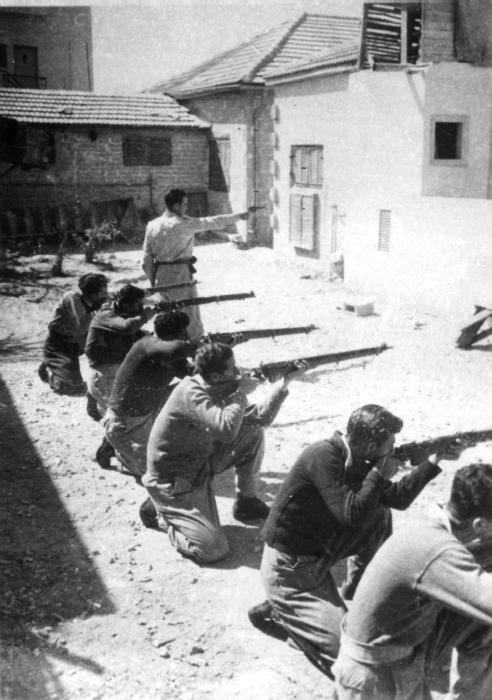The Etzel, or the Irgun, was a Zionist semi-militarized organization that operated between 1931 and 1948 in Mandate Palestine. The Etzel was formed in 1931 as a more radical offshoot of the older and larger Haganah. In other words, a group formed in the early 1920s by existing militias to defend Jewish settlements from Arab attacks. So the Etzel believed in the Zionist ideology of wanting to create a Jewish state. However, it did not agree with the Haganah on the way to achieve it; so they broke off to form a new more militant group.

Credit: Jabotinsky Institute in Israel, CC BY 2.5, via Wikimedia Commons
The Etzel and Revisionist Zionism
Ze’ev Jabotinsky founds the Etzel. The organization got formed on the policy of Revisionist Zionism. It differed from other types of Zionism in that its members wanted to occupy the territory covered by the League of Nations and not just sections of it.
So in 1936, the Etzel became an instrument of the Revisionist Party. That is, today, an extreme nationalist group whose doctrine called for the use of force, if necessary, to establish a Jewish state on both sides of the Jordan. In addition to being violently anti-Arab, the Etzel committed many acts of assassination and terrorism against the British, who they regarded as illegal occupiers.

While the Irgun was described as a terrorist organization by the United Nations and the British, the organization’s tactics were acceptable to many Jews who firmly believed that any action taken that worked towards creating a Jewish state was justified.
The Eztel is best known for two notorious operations: First was the bombing of the King David Hotel in Jerusalem in July of 1946. Second is the Deir Yassin massacre. The last they carried out with the extreme right-wing group, the Lehi, was in April 1948.

The Etzel was also vehemently opposed to the British White Paper on Palestine published in 1939 that “called for the establishment of a Jewish national home in an independent Palestinian state within 10 years” and “limited Jewish immigration to 75,000 for five years.” Moreover, the paper also stated that “Jews were restricted from buying Arab land in all but 5% of the Mandate.” In other words, the white paper meant the end of a Jewish state for the Jewish People.
Illegal Immigration
After the publication of the White Paper, the Etzel participated in the organization of illegal immigration into Palestine. They followed Jabotinsky’s “Evacuation Plan”. In other words, it aimed to see millions of European Jews brought to Palestine to help create a Jewish state. Many Eztel fighters were killed by the British during these clandestine immigration forays. On the other hand, the Eztel retaliates by executing many British army hostages.


When the Second World War ended, it became clear that Britain had no intention of changing its Anti-Zionist policy. So the Eztel joined forces with the Haganah and the extreme right-wing group (the Lehi); to form a unified Jewish Resistance Movement to resist the British. This unified front would form the basis of the Israeli Defense Forces when Israel was declared a state in 1948.
A Nation Can Not Live on Its Sword Forever
I like to elaborate on these organizations on my private tours of Israel. Each one is its own museum we can visit and learn about them. For example, the Haganah Museum is right in the middle of Rotchild Boulevard. And the Museum honoring Etzel is also not far away. Ultimately, these men and women sacrificed their lives so we could have a Jewish state here. Despite all the hardships and against all odds, they made it happen—a tremendous sacrifice, in my opinion.

One of the Museums that is my personal favorite is the Palmach Museum, just next to Tel Aviv University and Itzahk Rabin center. Rabin is an excellent example of these men and women who fought for a state. But in his case, I think he understood at some point that a nation could not live on its sword forever. And you must seek to make peace with your enemy at some point. Because if not, you wouldn’t be able to exist for a long time. Each time you examine history, a nation that cannot reach a peace agreement with its neighboring countries; can’t last long. For example, the crusaders were seen as a foreign element and eventually lost to the Arabs.
A Last Ending Note
Alright then, so after learning a bit about the Etzel! I hope to see you on one of my tours and that we can explore this fascinating period and Israel’s modern history. There are many things to see in Tel Aviv that relate to this subject, and I assure you won’t stop listening because these stories of these young men and women would make you tear up!
For example, young and so young men and women came from the horrors of the Holocaust. Without knowing Hebrew, barely weighing enough to carry their weight went to the front without thinking about too much. But the problem was that when they died, their entire family died with them. Since they were the very last living remnants of these families, so sad these stories, but on the other show the bravery and the willingness to sacrifice for the whole nation.







